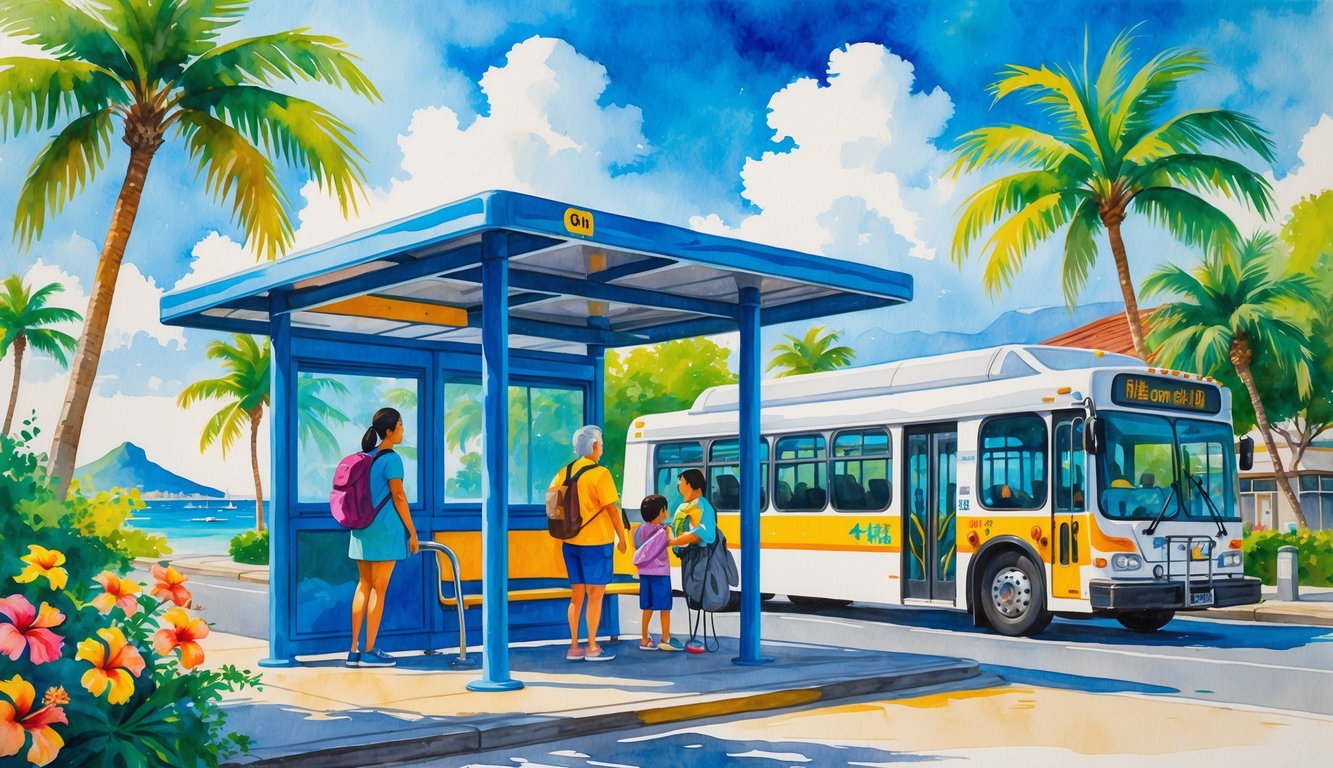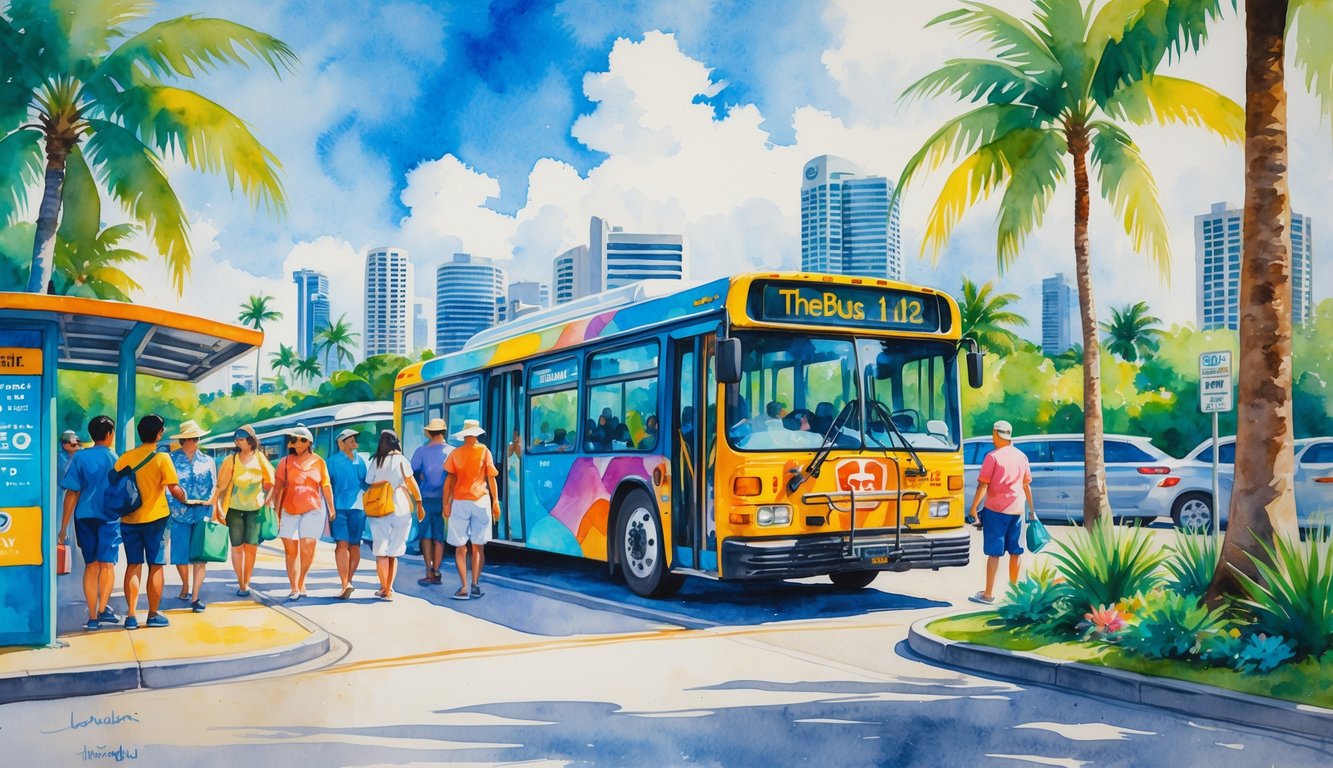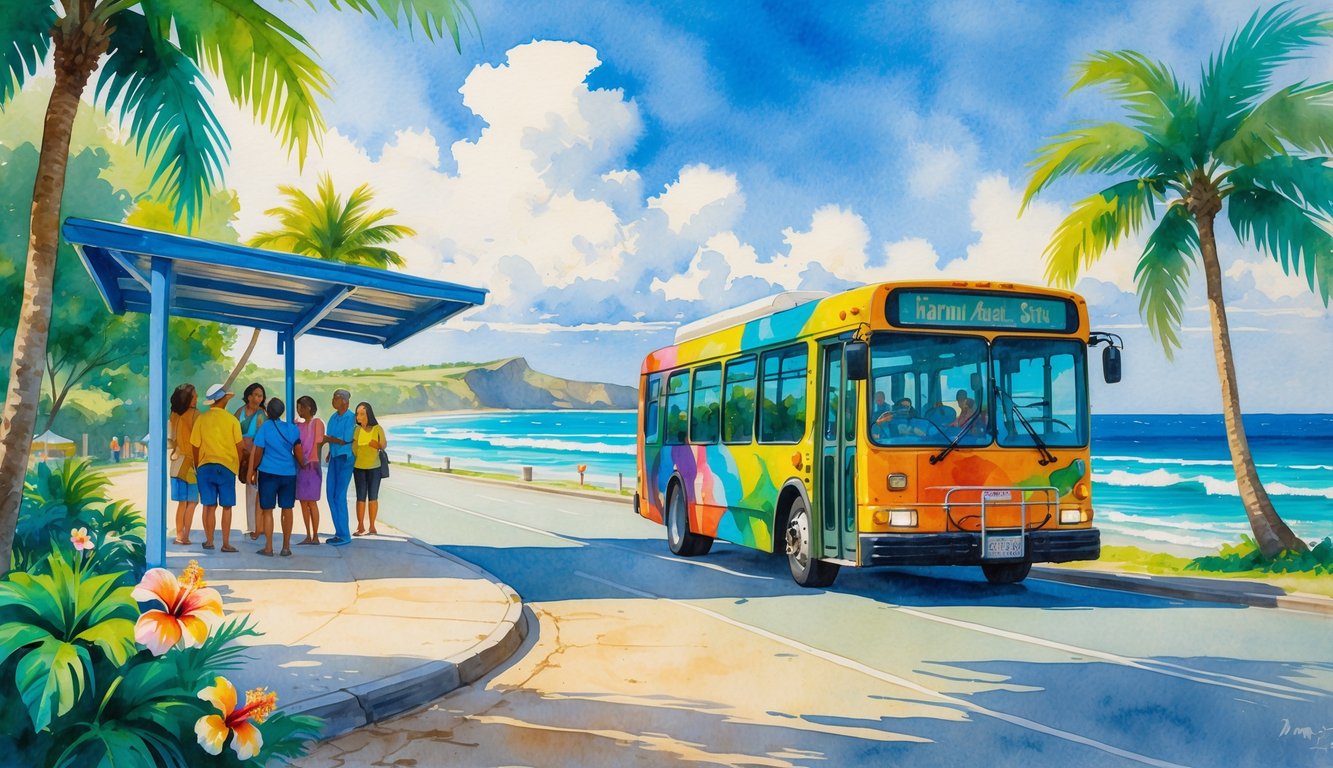Whenever I visit Honolulu, I rely on TheBus to get around Oahu. It’s a budget-friendly public transit system that makes it easy to explore Hawaii’s capital and its neighborhoods, beaches, and attractions.


When I learn how to use TheBus in Honolulu, I can get where I need to go without renting a car or worrying about parking. The buses cover a wide area, and most are accessible for people of all abilities.
Each bus has bike racks, which helps if I want to explore more once I reach my stop. I follow the rules, like keeping my phone on silent, and use a few key tips to travel smoothly.
If you want local advice and step-by-step instructions, TheBus has an official site with helpful details about routes, passes, and riding tips.
Understanding TheBus System
I find it easy to get around Oahu without a car by using TheBus. The public transit system connects Honolulu and many neighborhoods, so I can explore the island on a budget.
Overview of TheBus in Honolulu
TheBus is Honolulu’s main public bus system. It covers most of Oahu, including urban, suburban, and some rural areas.
Both residents and visitors use it every day. The buses are modern, air-conditioned, and usually run on time.
I can catch a bus every day of the year, even on holidays. This makes it a reliable way to get to Waikiki, Pearl Harbor, or the North Shore.
There are different fare types for adults, youth, and seniors. I use a HOLO card, a reloadable smart card that lets me board and transfer between buses easily.
How The Public Bus System Works
I can pay with cash or a HOLO card when I board TheBus. The HOLO card is convenient because I just tap it on the reader as I get on.
If I use cash, I need exact change. Bus stops have blue and white signs.
When I wait at a stop, I check the route number on the front of the bus to make sure it’s the one I want. I use apps like Google Maps or the official TheBus website to plan my trip.
Buses make regular stops. I pull the cord above the seat to let the driver know I want to get off at the next stop.
Coverage Across Oahu
TheBus connects Honolulu with towns and attractions across Oahu. I can get to places like Ala Moana Center, Diamond Head, and beaches away from Waikiki.
| Area | Examples of Destinations |
|---|---|
| Urban | Downtown, Waikiki |
| Suburban | Pearl City, Kapolei |
| Rural/North | Haleiwa, North Shore Beaches |
| East Oahu | Hawaii Kai, Hanauma Bay |
Buses usually run from early morning until late at night. The system links busy spots and neighborhoods, making Oahu accessible for first-time visitors.
Getting Started With Fares and Passes
To ride TheBus in Honolulu, I need to know how to pay the fare and which pass I might need. There are options for one-way rides, unlimited rides, and discounted fares for some riders.
Using a Holo Card
The easiest way to pay for TheBus is with a HOLO card. This reusable smart card lets me tap and board any bus in Honolulu.
I can buy a HOLO card at many stores around the island or online. After I get the card, I load money onto it and tap it on the reader as I board.
The system charges the correct fare automatically. Daily and monthly caps help me save money.
If I reach the cost of a day pass in one day, I get unlimited rides for the rest of the day. HOLO cards also work on Honolulu’s Skyline rail, so I don’t need different passes for different transit systems.
More details are on the official TheBus website.
Purchasing Bus Passes
If I plan to ride TheBus often, I can get a day pass, a 4-day pass, a 7-day pass, or a monthly pass. These passes allow unlimited rides within their valid time period.
I can buy passes from HOLO card vendors, online, or at select stores. The 4-day pass is useful for visitors because it gives unlimited bus rides for four straight days.
| Pass Type | Validity | Price |
|---|---|---|
| Day Pass | 1 day (unlimited) | $7.50 |
| 4-Day Visitor Pass | 4 days (unlimited) | Varies |
| 7-Day Pass | 7 days (unlimited) | $30.00 |
| Monthly Pass | Calendar month | Varies |
You can find more details at Go Hawaii’s transit guide.
Exact Change and Payment Options
If I don’t have a HOLO card or pass, I pay the fare in cash. TheBus does not give change, so I need exact change.
The current single fare is $3.00 and includes 2.5 hours of unlimited transfers. I can use my HOLO card for contactless payment, which works instantly and includes accessibility features.
Reduced fares are available for seniors, youth, and people with disabilities, but I have to register and get a special reduced-fare HOLO card. If I have questions about fares, I check thebus.org or ask the driver.
Planning Your Bus Trip
To ride TheBus in Honolulu, I check bus routes and schedules, use travel planning tools, and read bus stop information. These steps help me reach my destination smoothly.
Finding Bus Routes and Schedules
When I plan my trip, I check the current bus routes and schedules online. The official website for TheBus has a detailed map of routes across Oahu, showing bus stop locations and where each route goes.
I can see which routes connect and when each bus is scheduled to arrive. The website has a “Plan Your Trip” tool where I enter my start and end locations to get recommended routes and times.
The schedule section lists when every bus comes by each stop, so I don’t miss my ride. For updates about delays or changes, I check the official TheBus site.
Using Google Maps and Transit Apps
I use Google Maps or a transit app to get step-by-step bus directions. I type in my starting address and destination, and the app gives me route choices, departure times, and walking directions to the nearest bus stop.
Google Maps shows if I need to transfer to another bus and gives real-time arrival info for many Honolulu routes. Other transit apps also help me plan trips and check bus schedules.
TheBus website has a Google Transit Planner that lets me pick when I want to leave or arrive and find the best route. This is helpful if I’m new to the city.
I like checking my plans with just one tap.
Reading Bus Stop Information
At every bus stop, I look for signs with the bus stop number and route numbers. Each sign usually lists which buses stop there and a short schedule with main times.
If I’m unsure, I check the bus stop number and enter it into TheBus website or a transit app for up-to-date arrival times. Some stops show a small map or list of popular destinations served by each bus.
The information is printed in large, easy-to-read text, so I know I’m in the right place. If I need more details, I use online tools because they often have more times than the printed signs.
Having the right stop information helps me feel confident that I’m catching the right bus, even if I haven’t used that stop before.
Boarding and Riding TheBus
When I use TheBus in Honolulu, I pay attention to where I wait, how I talk to the bus driver, and how I load my bike or use accessibility features. Knowing these steps makes my trip smoother.
Waiting at the Bus Stop
I check TheBus timetable to know when my bus will arrive. At the bus stop, I stand on the sidewalk and look for the yellow and blue sign with the route numbers.
To signal the bus, I step forward and wave as my bus approaches. I stay behind the curb until the bus stops.
If the stop is crowded, I form a line and wait my turn. If it’s dark or raining, I use a phone light or wear bright clothing so the driver can see me.
Interacting With Bus Drivers
When I get on TheBus, I greet the driver with a “hello.” If I am not sure about my route, I ask the driver for help.
For payment, I have my HOLO card or exact cash ready because bus drivers do not give change. The current fare is usually around $3 for adults, but special rates apply for students, seniors, and others (see recent details at TheBus Fares and Passes).
If I need a transfer, I request one before finding a seat. I follow the posted rules, such as keeping my phone silent, because drivers can remind me or ask me to leave at the next stop if I do not follow these rules.
Respecting the driver and other riders makes the ride better for everyone.
Using Bike Racks and Accessibility Features
Bringing my bike is easy because every bus has a rack on the front. Before the bus arrives, I let the driver know I want to load my bike.
I lower the rack, place my bike in an empty slot, and secure it before boarding. At my stop, I remind the driver I need to remove my bike.
Buses serve everyone. I see ramps or lifts for wheelchairs and priority seating for people with disabilities or seniors.
When someone needs extra help, the driver uses the bus’s accessibility features. If I need assistance, I can ask the driver, and they are usually glad to help.
For more details and step-by-step guides, I check How To Ride – TheBus.
Transfers and Connections

When I ride TheBus in Honolulu, making transfers and finding good connections helps me reach my final stop faster. I need to know how transfer tickets work and understand my options for express and Skyline routes.
I also plan if I want to connect with rental cars or other transit choices.
Getting a Transfer Ticket
When I pay my fare, I ask the driver for a transfer ticket if I plan to switch buses. The transfer ticket lets me get onto another bus without paying again, as long as I use it within a set time, usually about two hours.
I make sure not to lose my ticket. Each ticket shows the exact time it expires, so I check the clock before boarding my next bus.
If I need to make more than one transfer, I try to do it quickly so I don’t run out of time. When I use a HOLO card, transfers happen automatically.
I just tap my card when I board each bus, and the fare system checks if I’m still within my transfer window.
Using Express Routes and Skyline
Honolulu offers several express routes that help me move across the island faster, especially during rush hours. I look for routes like TheBus E CountryExpress! for quick trips from places like Waikīkī to Ala Moana Center.
These lines make fewer stops, so I can save time. If I’m traveling between East Kapolei and downtown Honolulu, I use the new Skyline rail system.
I pay with my HOLO card, just like on the bus, so it’s easy to switch between the two. The Skyline connects with key TheBus stops, letting me transfer smoothly.
For schedules and more info on routes, I check TheBus website or the Oahu public transportation guide.
Connecting to Rental Cars and Other Transit
Sometimes I need a rental car for part of my trip. Bus routes like 20 and 303 stop at the Daniel K. Inouye Honolulu International Airport, making it easy for me to transfer between TheBus and a rental car company at the airport.
Route 20 also connects me to busy spots like Ala Moana Center and Waikīkī, giving me flexibility depending on which rental car site I pick. The main transit centers, like Ala Moana Center and Kalihi Transit Center, serve as hubs.
From here, I can switch to other buses or find nearby options, like taxis and shuttles. If I need accessibility accommodations, TheHandi-Van service helps those who qualify and serves visitors who can’t use TheBus for up to 21 days a year.
For more information on stops and connections, I visit How to Ride TheBus.
Popular Destinations Reached by TheBus

TheBus makes travel in Honolulu simple for both locals and visitors. I can reach attractions, beaches, malls, and historical sites quickly by using the well-connected routes.
Waikīkī and Waikiki
Waikīkī is famous for its sandy beaches, surf spots, and lively nightlife. When I take TheBus, it drops me off along Kuhio Avenue, giving me easy access to hotels, shops, and the oceanfront.
Some of the most visited spots—like Waikīkī Beach, Honolulu Zoo, and Kapiolani Park—are all close to these main bus stops. Buses arrive every 10 to 30 minutes, so I never wait long to get around.
Waikīkī is also great for seeing daily Hawaiian life. I can easily join festivals, watch street performers, or grab some local food.
I like knowing that using public transportation is both affordable and eco-friendly. The frequent bus service means I don’t have to worry about parking or traffic.
Learn more about traveling by bus in Waikīkī and Honolulu.
Ala Moana Center and Shopping Center
Ala Moana Center is the largest open-air shopping mall in the world. TheBus has several routes that stop right at the shopping center entrance, making it simple for me to visit over 350 stores like Macy’s, Uniqlo, and local boutiques.
I can also find a wide range of restaurants, from quick bites to fine dining in the food court. If I want a break, I walk to Ala Moana Beach Park nearby, which is also a bus stop.
Buses between Waikīkī and Ala Moana run often, so I don’t have to plan much in advance for shopping trips. Besides shopping, it’s easy to join community events and watch free performances at the mall.
Schedules and stop information can be found through Oahu public transportation.
Pearl Harbor and Sea Life Park
Pearl Harbor is a site I always recommend because of its rich history and museums like the USS Arizona Memorial. TheBus offers direct routes from downtown and Ala Moana, which helps since parking can fill up early.
Route 20 or 42 takes me from Waikīkī or downtown straight to the visitor entrance. I save money on parking while learning about World War II history.
Sea Life Park sits on the east side of the island along the coast. TheBus Route 22 (“Beach Bus”) takes me from Waikīkī, past scenic ocean views, right to the park’s entrance.
I can see dolphins, sea lions, and even small sharks after a relaxing ride along the shoreline.
Exploring North Shore
The North Shore is famous for big waves, surf competitions, and unique towns like Haleʻiwa. I use TheBus to visit beaches such as Waimea Bay, Sunset Beach, and the Banzai Pipeline.
Routes 52 and 60 connect me from downtown or Ala Moana to the North Shore. The ride gives beautiful views of mountains, sugarcane fields, and coastline.
I can stop in Haleʻiwa for lunch, wander through shops, or try famous shave ice. TheBus is convenient because I don’t have to rent a car for the whole day.
I use bus transfers to see multiple spots in one trip. You can find more about bus schedules to the North Shore at Oahu bus routes and tips.
Helpful Tips for a Smooth Ride

I want my bus travel to be as easy as possible. Packing right, following the rules, and knowing what to do if I lose something can make taking public transit in Honolulu a lot better.
Traveling With Luggage and Personal Items
When I travel with TheBus in Honolulu, I follow the rules about baggage. Luggage and bags can’t block the seat next to me, anyone’s way in the aisle, or the door.
I keep my things on my lap or right beside me, taking up as little space as possible.
Quick Tips for Luggage:
- Soft bags fit better than hard suitcases.
- I avoid bringing oversized items, as they might not be allowed.
- If I have many groceries or shopping bags, I tie them together so they’re easier to carry and hold.
- Strollers should be folded before getting on TheBus.
If my items are too large, the driver might ask me to wait for the next bus or not allow them onboard. That keeps the ride smooth for everyone.
You can find more about rules and what’s allowed from TheBus guidelines.
Understanding Bus Etiquette
Polite behavior makes public transit easier for everyone. I always greet the bus driver and follow their instructions.
I keep my phone on silent and avoid loud conversations or music, as Honolulu rules say phones must be silent on TheBus. If I break these rules, the driver could remind me or even ask me to get off at the next stop—see more about etiquette at this guide.
Here’s what I do:
- I don’t eat or drink on the bus.
- I give up my seat for seniors, people with disabilities, or pregnant passengers.
- I keep my feet off seats and use headphones if I listen to music.
Staying quiet and keeping my space tidy helps when buses are crowded, especially during peak hours.
Dealing With Lost & Found
If I leave something behind on TheBus, I follow a few steps to try to get it back. First, I write down the bus number, route, and the time I was riding if I remember.
Then, I contact TheBus Lost & Found at the main office.
How I handle it:
- I call (808) 848-5555 as soon as I notice something is missing.
- I give a clear description of what I lost and where I was sitting.
Lost items may take a day or two to turn up because staff need to check all vehicles.
If I find something left behind by someone else, I give it to the driver right away. This helps the item get back to its owner.
For more details, visit the official TheBus website for up-to-date contact info.




